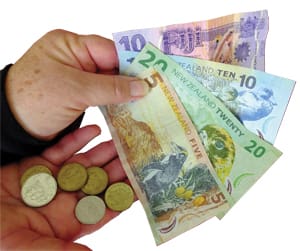Money makes the world go ‘round, and if you’re already cruising or just planning your waterway adventure, it’s one of the necessary pieces of gear you’ll need to keep you afloat! Money is one thing that often keeps people from untying the dock lines in the first place and causes stress when already underway. After all, many of us gave up a steady paycheck to take on the voyaging lifestyle.
We compiled eight years of detailed documentation from when we lived aboard full time, and discovered that it cost us an average of $30,000 a year to cruise (minus health and boat insurance). This included all the day-to-day living expenses as well as boat repairs and maintenance, fuel, customs fees, medical expenses and even a few airline trips back to the U.S. from foreign ports. Everyone spends differently, so your costs may be higher or lower. You can check out a detailed article on the cost of cruising in the 2016 edition of Ocean Voyager.
But this article isn’t about how much it’ll cost you to sail into your dream lifestyle. It’s about getting and spending your hard-earned money during your cruise — dealing with the dollars, euros, lempiras, pesos or whatever country’s currency you’ll be using.
Dealing with cash aboard has gotten so much easier over the years. When we first started in 2000, we had to have a family member help us with paying some bills and checking on our credit card charges. We were not early adopters of Internet banking. Today, thanks to the Internet and online banking options, life is much less complicated aboard. Many more islands take credit cards, ATMs are more prevalent, online banking is way easier and even money transferring options have come a long way.
Before you leave the dock and plan to head to foreign ports, here are a few things to think about and get in order before leaving.
Cash
The U.S. dollar is widely accepted and easily exchanged, especially in the Caribbean. But if you venture off the beaten path or farther away into the Southern Hemisphere or Europe, or if you want to get off the tourist track then you’ll need to get comfortable with handling local currency. Local currency is always more fun to use because it adds to your cruising experience and can save you money. You often get an unfair exchange rate in many restaurants or places if you use dollars in lieu of the local currency. Small “mom and pop” restaurants, cabs, local fresh markets or small shops simply won’t take foreign currency. If you want an ice cream on the street or a beer at a “locals” hangout, you’ll need local spending money.
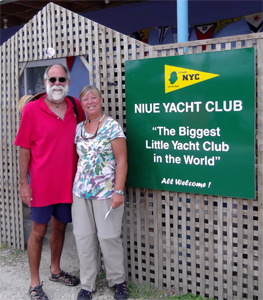 |
|
Michael and Barbara at Niue Yacht Club. |
We kept a stash of U.S. dollars hidden aboard and recommend that you start saving all your best currency because bills that are old, wrinkled, marked in any way or torn will NOT be accepted at currency exchanges. Friends who came to visit us often helped resupply our stash, and we’d give them a check when they arrived. Now with all types of mobile and web-based payment services like Venmo, that process can be even easier with friends not having to front you the cash.
If at all possible, get a small amount of local currency prior to getting to a new country. Nothing beats having some local cash to get a cold drink or quick snack as soon as you arrive. You may also need to take a bus or cab to do your clearance into a country and will need local cash to get to the location. Banks, credit unions, money exchange kiosks (at international airports), Western Union and others can provide you some local currency. Having lots of options means you need to do your due diligence to check on the best exchange rates and fees. You may have to give your bank notice so they can get the currency in-house. Don’t load up too much, as we found you get a better rate once inside the country and often the fees are less. And the fees can certainly add up!
Once you are underway, another source for local cash is other cruising boats. We often “bought” local money off other boats that had recently left that particular country. We agreed on a fair exchange that would help them get rid of coins and small cash from a country they were leaving and restock their supply of U.S. dollars from us. Morning cruiser radio nets are a good place to ask if anyone has currency for your upcoming stop.
Once in a new country, we’d ask around for the best exchange rate. Fellow cruisers who have been there, the local marina or even the customs and immigration folks you meet on arrival are good sources.
We’d then bring some of our favorite American dollars to a bank or exchange and get local currency. Upon arrival in New Zealand, I went to one bank and the teller told me, “You don’t want to exchange that here, go across the street to the other bank. I have to charge you $5 for the exchange, they don’t charge anything!” Plus the exchange rate was exactly the same. Now that’s honesty and so typical of what we found in New Zealand. So be sure to check around before cashing in.
Another way to get local cash is through your credit card with a cash advance given in local currency. There are bank machines in most major cities, even on smaller islands, that will allow you to do this. But be aware of extra bank fees for using some ATMs, foreign transaction fees and the exchange rate you’ll be charged — plus you’ll be paying interest on the cash you receive from the moment that the money spits out.
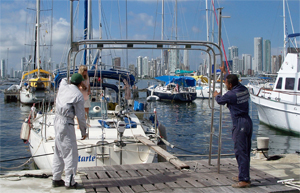 |
|
A new arch built in Cartagena, Colombia. The builders required cash. |
Check with your local bank before you leave to see if your debit card will work at international ATMs or banks. Some banks do have international partners or even branches. This will save you the cash advance interest of a credit card, but you may have to pay high foreign transaction fees (FTF) and even an ATM use fee. Get the info before you leave so you can figure out the best option for you.
Once you have your new currency in hand, take some time to figure out what the coins and bills look like so you understand what’s what! Many kinds of foreign currency is quite colorful and beautiful.
Credit cards
Plastic is also a good and simple way to handle some of your transactions. For the bigger items like fuel, marinas or major repairs, we found that we could use a credit card to make the payment. But your card won’t work everywhere — especially once you leave the main towns. Make sure you have a card that does not charge you foreign transaction fees (FTF), which are fees that are imposed every time you use the card outside the U.S. These fees can add up quickly and are frankly unnecessary as many cards offer free foreign transactions, like the Capital One card we used that had no fees and offered a competitive exchange rate. Also, look for a card that provides you with low cash advance interest. Keep in mind that you’ll want to be able to look at your credit card purchases online regularly to make sure your card has not been compromised anywhere, and remember to set up alerts so you can be notified of usage and potential fraud. Pick your card wisely, as not all credit cards are accepted everywhere. Visa and MasterCard seem to be the ones that were easiest to use, at least in our cruising territory (Caribbean, Pacific, South Pacific).
Have a backup card buried on board someplace, ideally one from a different company or at least a totally different account number. If your card is compromised, lost or stolen in a remote location, you may have to wait some time to get a replacement card, so having an alternate card may come in handy. We know of a group of cruisers in Fiji who had an issue at one bank machine and all their cards were hacked. It took several people almost a month to get a card replacement. Having a backup can be handy. Keep the numbers of your card someplace safe, as well as the international phone numbers to contact your credit card company. Many companies allow you to call collect if your card is stolen or lost.
It’s important to alert your credit card company to your travel plans. We would update with Capital One quarterly where we would be and they kept watch for any card use outside that area. It was a simple email or phone call to alert them.
We rarely used our card to get cash advances because of the interest cost, but on occasion we had to do so. Because the cost of advanced cash has a relatively high interest rate that kicks in the moment you receive your money, you’ll want to pay it off as quickly as possible. We would often pay off the card as soon as we made the cash advance transaction and it appeared when we checked online. That way, we paid for as few days as possible for the benefit of local cash in hand.
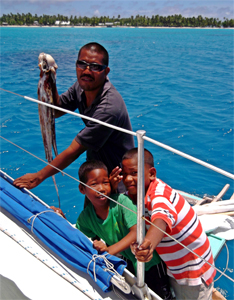 |
|
Buying octopus in Ailuk, Marshall Islands. |
When choosing a card, make sure your card has a chip and PIN. The U.S. has lagged behind on this technology and in some places we could not even use our mag strip card. After a big provisioning grocery run in New Caledonia, we were left standing in the grocery line because they could not accept a non-PIN credit card. Language difficulties made arguing about it too difficult, so we left without our $200 worth of provisions. In New Zealand, just about all fuel docks are automatic (without an attendant) and you simply use your chip and PIN card to fuel up. For the first few years that our cards didn’t have chips and PINs, we would pay a premium to get an attendant to come to the dock and we would have to go to an office that could accept the mag strip card. We finally got a chip/PIN card and that changed everything!
Debit cards
We did not deal with debit cards during our travels because of the additional costs in foreign bank machines, foreign transaction fees from our “home” bank and the higher risk of unauthorized use. Things have changed dramatically over the years in the protection area, but the thought that someone could clean out our bank account kept us nervous about using them regularly. When we had a bank account in New Zealand and cruised there (and did boat maintenance there) for about six months a year, we did use our local New Zealand debit card. New Zealand is a very “financially electronic” country — we found that people rarely used cash — so we would pay most of our large bills with the debit card/account transfer from our New Zealand account.
The debit card may be a good option for you to get local cash and pay bills if you know what your bank allows, what fees you’ll get charged for foreign transactions and what the exchange rate will be. Simply do your homework before heading offshore, and find out if your bank has international branches in your cruising area or if they have a partner bank.
Local banks
We settled into cruising the southwestern Pacific for the last several years and realized that because we would be in New Zealand five to six months and then the islands (Fiji, Vanuatu, New Caledonia, Tonga) for the remainder, it was helpful to open a local bank account in New Zealand. We went with ANZ, which has branches in most of the islands as well as New Zealand and Australia. This allowed us to use a bank debit card and get local currency in New Zealand as well as Fiji and Vanuatu. The cash came directly out of our account and had no advance fees or foreign exchange fees, making the cost of cash cheaper and certainly much easier. We would simply transfer some money each season from the U.S. to New Zealand and live off that. It also eliminated the need to carry so much U.S. currency on board.
Money transfer
Times have certainly changed when it comes to getting your money from one country to another. There are also lots of rules and regulations that control the amount you can transfer. Many banks take care of this, though we had problems with smaller, regional American banks or credit unions that used different systems than the international banks. Before you leave, make sure your bank or brokerage company is capable of getting you money wherever you are. You never know when you might have an emergency and need cash for repairs or a medical crisis. Sometimes you’ll need to sign some paperwork to transfer money from your account to foreign countries, so you’ll want to determine this before you leave. Develop a relationship with your bank or broker so you have a person you can trust.
You can also use money transfer companies. Western Union used to be one of the few, but now there are many options like Xoom and Forex. We had good luck with Forex/OFX for transferring money. It works both ways as well; if you need to send money to your accounts or an individual, or if you need to receive funds, it is another option in your portfolio. There were Western Union offices in almost every country we traveled. We used a few to exchange our cash as they sometimes had the best rates and no fees.
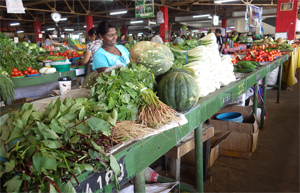 |
|
Local markets are great places to pick up vegetables, but you’ll need local currency. |
Credit lock
Before we left port, we did lock our credit. Once you have your credit cards in hand (one main one and a backup), you probably won’t be seeking new loans or cards while sailing. By locking our credit, nobody could open up an account in our name — this gave gave us some peace of mind. It is even easier to do today than when we did it, but we believe it was another reason we didn’t have any problems in our cruising areas while being gone for nine years.
Bottom line
It is part of the fun to get, learn and use local currencies. You’ll figure out your own systems and what works for you. We have been very lucky in nine years of cruising to not have any major issues in this area. The biggest problem we ever had was with paying a boat haulout bill in Honduras, but our credit card company (Capital One) was stellar in helping us resolve it. The other was the issue of having a card that didn’t have a chip, but that seems to be less of a problem these days.
We did some weird (and, looking back, scary) exchanges during our cruising years. Like exchanging $1,000 in cash for millions of pesos in Colombia to pay a local welder for our newly built stainless arch for our boat Astarte. The vendor who built the arch didn’t take credit cards — he built the arch in an open-air garage with chickens running around! In downtown Cartagena, we had to ask the money exchange place that was right on the street corner to take us to the back room so everyone around wouldn’t see us getting these stacks of pesos being counted out!
Just like everywhere, when it comes to handling cash you have to be vigilant. Don’t walk around flashing cash and credit cards. Know your surroundings and have only the amount you’ll need on you. If exchanging cash or using an ATM, do it in the daytime and be aware of your surroundings. Ask to be more discreet or go to a less obvious room if you need to be less visible.
We cruised and lived on our boat for nine years, visiting hundreds of small islands and dozens of countries without a problem. We always kept our small coins and bills handy for a street ice cream or the fresh veggie markets. Making change is often difficult for some of these small-business people, so get smaller denominations when you get your cash at a bank or exchange. On board, we didn’t keep all our U.S. dollars in one location and never told anyone where they were.
With the Internet now more available worldwide and with electronic banking getting easier and easier, what we had to do in the earlier years of our cruising is long gone. You’ll figure out what works best for you and for the cruising grounds you’ll be exploring. Just remember that small, remote locations won’t take a credit card, U.S. dollars or checks. If you don’t have the local currency on hand, you may be able to trade with something you have on board like eyeglasses, sunglasses, tools or even spices!
Start saving and enjoy spending it in exotic locations on experiences that will last a lifetime.
Barbara Sobocinski and Michael K. Hawkins cruised full time from 2009 through 2019 in their Moody 42 SV Astarte and sold the boat in New Zealand in 2019. They are looking for their next adventure after more than three decades of boating.

